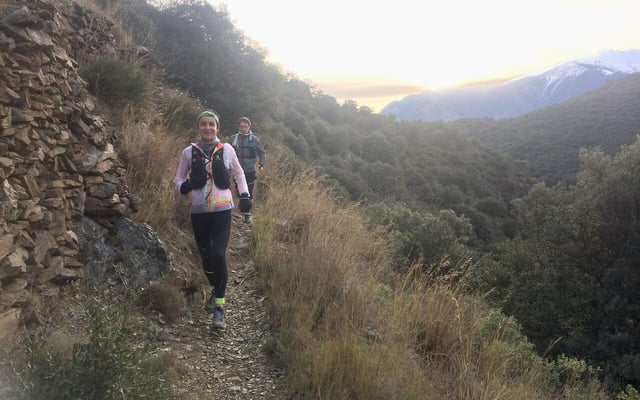Why are some of the runs in my training plan so short?

I’m a member of a few training groups on facebook and a question that often comes up is why some runs in a training plan are very short. When people are used to running one hour plus and are keen to get fitter and faster they can feel very confused to be told to run for 30 minutes easy on the first day of their new training plan.
So why are some planned runs so short? Well there are many benefits of short runs which I will go into more detail about later but the main thing to state is that short runs can play an important role in getting you fitter and faster. In short:-
- Longer does not always mean better
- Short runs are not just for beginners
Here are some of the benefits of short runs:
- A way to turn the legs and activate the muscles and mitochondria which can promote recovery
- A way to get in some easy extra endurance miles
- A way to do some good quality High Intensity Interval Training (HIIT)
- A way to warm up before some strength and conditioning
- A way to focus on form by putting into practise running drills
- A way to come back after over-training or injury
- A way to increase the frequency of running.
So let’s take each of these in turn and have a closer look.
A way to turn the legs and activate the muscles and mitochondria which can promote recovery.
Doing an easy run can be a good way to promote recovery. By increasing the energy demands of the cells in the muscles you are encouraging the production of more mitochondria (the part of the cell where reactions to make energy occur). Once more mitochondria are produced this encourages muscular recovery to occur more quickly in general, making you more resilient to more running longer term. A short amount of gentle exercise can also help flush out some of lactate build up after a hard session helping you be fresher for your next session.
However, the jury is out on this! Whilst many runners will swear by an easy 20 to 30 minutes to help them recovery, the research at best shows very little effect. That said, for those who really struggle not to run, a short easy session is not going to interfere with their recovery and may help them psychologically more than doing nothing at all.
I like to include short easy runs of up to 40 minutes after a hard block of training to ensure that the goal of recovery is achieved; this can be at the beginning of the week after the hard weekend block of training, or for several days over the course of a recovery week.
A way to get in some easy extra endurance miles
For those of you who have read my article on training twice a day, often this can be a great way to increase the amount of endurance training you do (it can be easier to find two lots of thirty minutes in a day than one hour). For example you might be able to use your lunch break to do thirty minutes, still have some time for lunch and then be able to find 30 minutes to train in the evening whilst still being home for bedtime story with the kids.
A short easy run of 20-30 minutes is also a great way to add a second daily run to your routine if you are looking to increase your mileage and have no other way of doing so. In particular, running a 6 and a 3 mile run with a period of recovery in between is going to give you less tired legs than doing a 9 mile run, leaving your fresher for the harder sessions.

A way to do some good quality High Intensity Interval Training (HIIT)
One of my clients has recently become a dad and has spent some time working out a good balance between his new dad duties, full time work and training. He has worked out that he has 30-40 minutes to spare most days so for him the only option is for him to do shorter workouts. With less time on his feet, however, given he still has youth on his side, he may be able to increase the quality of one of his sessions so that he is doing three higher quality sessions a week rather than two. High Intensity Interval Training is a really good way to make good fitness gains in a small amount of time, so long as you make sure you have enough recovery between the sessions.
A couple of sessions that I like to prescribe which are short but give great fitness gains are
30/30 – after a good warm up including some faster paced running to get the heart pumping run hard for 30 seconds and easy for 30 seconds. You can start with 8 repeats and increase the number of reps each week according to time. Cool down for ten minutes afterwards. So you could do a great session, including 12 x 30/30 with warm up and cool down in 31 minutes.
1 minute on 1 minute off – after a 10 minute warm up including some faster running run hard for 1 minute and easy for 1 minute, repeat 10 times then cool down for 10 minutes. This is another great session which you can complete in 40 minutes.
A way to warm up before some strength and conditioning
The base phase of training is a great time to focus on some good quality strength training. It can however, feel counterintuitive for athletes not to run so a good compromise is to do 20 to 30 minutes easy running before the session by way of a warm up. Including some good arm swings in the run will not only attract the attention of passers-by but ensure you that have adequately warmed up your upper body as well as legs, hamstrings, glutes etc.
A way to focus on form by putting into practise running drills
If you have watched my YouTube video on running drills you will know that improving your running form is a great way to gain some ‘free speed’ in your running. A good way to embed the learning is to go for a short easy run after the drills and focus on running form as you run.
A way to come back after over-training or injury
In 2014 after one of the most stressful years of my life, I was over-trained. As running is both my way of keeping fit and my way of maintaining mental wellness, not running was difficult. The way my coach and I managed my recovery was to do a maximum of 35 minutes of running; I found that I could support an easy 35 minutes both morning and evening. Not only was 35 minutes an easy run for me at that time, but psychologically it did not seem daunting. It enabled me to keep a good running routine and recovery at the same time.
A way to increase the frequency of running.
If you have read my article on running twice a day you will see that I mention that there are some fitness advantages to running more frequently for shorter periods of time. Physiologically the hormones and chemical reactions that take place when doing a single work out enhance the body’s adaptation to the training. Basically your body will adapt more if you stimulate it more times than if you stimulate once for a longer period of time.
This is not to say that you should abandon long runs altogether, they have their role to play in increasing your endurance and adaptation to continuous exercise, especially if your goal event is a long one.
The other advantage of shorter more frequent training is it lends itself more to consistent training and consistency is the key to getting fitter. It can be difficult to find the time (and motivation) to train for over an hour and this can lead to missed workouts; far better to do three shorter workouts per week consistently than 2 longer workouts inconsistently.

Additional Questions
If I miss a short run should I just tag it onto another short run? The best thing to do if you are unsure how to execute your plan after missing a session is to contact the writer of the plan; they will have the knowledge about the purpose of the run and what best to do next. My usual protocol with training is never to try to ‘make up’ for lost training; if it’s gone it’s gone, move on from the position you are in now.
What if I’m just not motivated to go out for less than an hour? If you really feel you need to invest a full hour in training, I would suggest doing the planned run and follow it with some good stretching routines and a bit of foam rolling. This will help keep your body working and maintain the purpose and length of the planned run. Remember: longer is not always better; shorter is not just for beginners.
Tags:
Mountain RunningJanuary 19, 2021

Comments